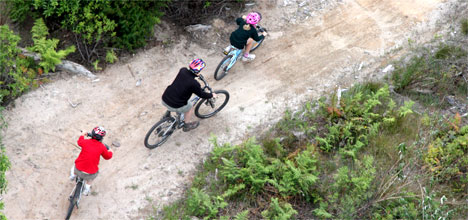Rich in history and tracing the steps of Maori and early settlers, the Motu Trails start in Opotiki and carves their way through spectacular coastal, bush and hill country.
Work began on the Motu Trails in 2010 and is one of 23 'great rides” officially sanctioned under Nga Haerenga – The New Zealand Cycle Trail Programme.
Bikers riding on the Motu Trails.
In three years, the track has made a name for itself for riders from around the country and Australia. This success has been outlined in an evaluation report released earlier this month by the Ministry for Business, Innovation and Employment.
The MBIE commissioned the in‐depth case studies focussing on four great rides: Hauraki Rail Trail, Mountains to Sea Trail, Queenstown Trails and the Motu Trails.
Data was collected during the first full peak summer season, from December 2012 to April 2013, for all the cycle trails with the report noting that it is 'still early days”. Overall, the study reported extremely positive results for the Motu Trails with excellent satisfaction ratings for track condition, signage, scenery and location, website and the technical levels of the rides chosen.
Opotiki District Council's parks, recreation and tourism manager Mike Houghton says the report had provided some really useful feedback on the trails and the satisfaction ratings and many of the verbatim comments from users that were 'absolutely glowing”.
'Over 96 per cent of people who used the Motu Trails said they were 'very likely” or 'likely” to recommend the trail to others. This is a great endorsement of the work we have put in to make this trail one of the best in the country. In terms of the overall experience, the Motu Trails recorded the highest level of overall satisfaction of the four trails,” Mike says.
The report also indicated that there were areas where the trails could have more impact on their supporting communities as the main economic impact is predominantly felt by businesses that are well-positioned in and around the trail.
'There is strong community support, goodwill and engagement with existing businesses and there are both new and diversified businesses that are benefiting from the trail.
Mike says some of the feedback provided in the survey indicated that visitors would like to see more supporting services around the trails (things including accommodation, food, bike hire and so on).
With the estimated economic contribution for the four month period around $245,000, there is certainly more opportunity to grow this tourism asset even further, says Mike.
'The report suggests that local businesses are ‘adopting a wait and see attitude', temporarily stretching resources to accommodate a short-term increase in demand while waiting until benefits are proven before investing further. And yet visitors using the tracks, almost without fail, said that the track was amazing and a real asset to the town.
'To me this looks like a classic chicken and egg situation – we need to get businesses supporting the trail network so that more people use the trails and those businesses serving the region. This is a real opportunity for the town to bring new business to the area and make the most of our nationally recognised asset,” Mr Houghton says.
Work continues on the Motu Trails and there are small and large projects constantly underway to improve existing trails or extend them into new areas.
In the New Year, work is scheduled to commence on the 'missing link” – an 800m section at Tirohanga joining up the middle portion of the 22km (return) Dunes Trail.
This section, along Tirohanga Bluff, is to be built on Department of Conservation land alongside Maori land. Much of the land around the site is sacred and council, Motu Trails Charitable Trust, Maori landowners and other stakeholders have worked closely to ensure that the trail location and construction respects the wahi tapu.
The new section will include an extension to the trail, a bridge and a boardwalk and work is expected to begin early in 2014.



0 comments
Leave a Comment
You must be logged in to make a comment.